Revolutionary War Resource Gems You May Not Know About!
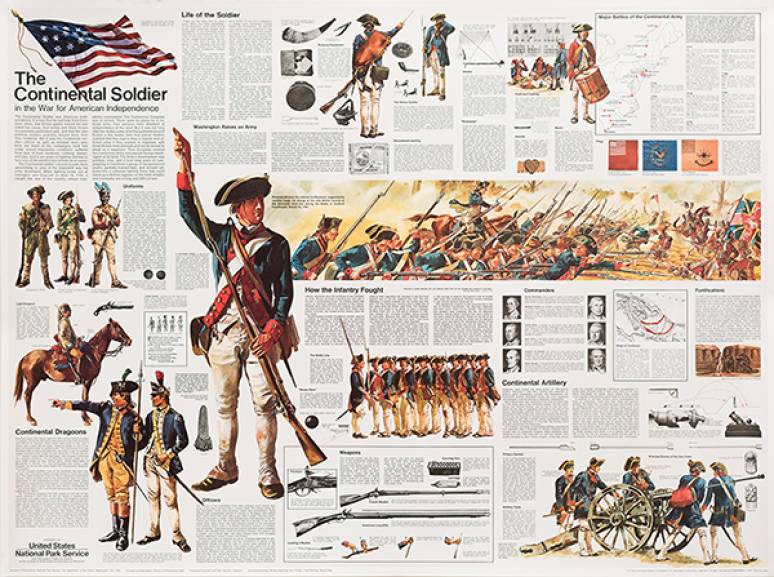
Most researchers are well-versed in the use of pension applications, bounty land warrant applications, and compiled service records in documenting Revolutionary War military service. These are the most commonly-sought resources pertaining to this conflict, but some lesser-known records are available that you may not be aware of. Records are also available that pertain to Americans who participated in numerous non-military ways. In this blog we’ll look at some of these resources; be sure to check them out later!
Many of the following digital records are in the National Archives catalog and on the free website FamilySearch, both accessible from anywhere. If you don’t already have a free username and password for FamilySearch, you’ll need to create them to view images.
War Department Collection of Revolutionary War Records (Record Group (RG) 93)
The National Archives (NARA) created an artificial collection of Revolutionary War documents through purchase or copying from various sources, known as the War Department Collection of Revolutionary War Records (Record Group (RG) 93 (NAID 422). This was due to an all-consuming fire in the War Department in 1800, the burning of Washington during the War of 1812, and the transfer of Revolutionary War military records to the War Department by the State, Interior, and Treasury Departments between 1893 and 1913. There are fifty-eight series within this record group; you can find a descriptive series list in the NARA catalog. Some of these records have been digitized. Also, FamilySearch has a digital copy of the Preliminary Inventory of the War Department Collection of Revolutionary War Records (1970) (Fig. 1).
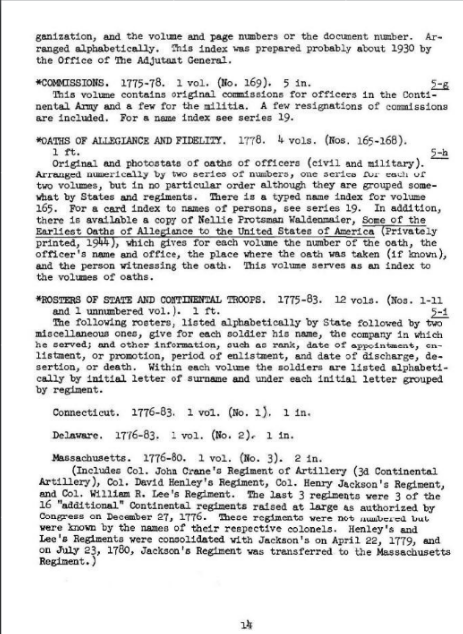
The War Department abstracted information from muster rolls, payrolls, and personnel reports and amassed them into compiled military service records (CMSRs). However, pay receipts, letters, supply returns, enlistment papers, and orders weren’t included in the CMSRs; they were separated into 199 numbered bound volumes and in a file of approximately 35,500 numbered unbound records. You should first consult NARA microfilm publication M847, Special Index to Numbered Records in the War Department Collection of Revolutionary War Records, 1775-1783, at FamilySearch. Alphabetically-arranged browsable card index by surname, it shows the person’s state, rank, or reason for mention in the original record (Fig. 2). You can also read the M847 descriptive pamphlet.
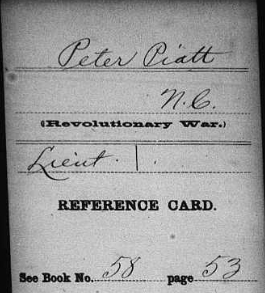
If the Special Index gives a “book” number (Fig. 2), check publication M853, Numbered Books Concerning Military Operations and Service, Pay, and Settlement of Account, and Supplies in the War Department Collection of Revolutionary War Records. Also available online at FamilySearch, these are “books” of records that contain orderly books (books of orders); oaths of allegiance and fidelity and oaths of office; lists of troops and letters, commissions and resignations, receipts; pay and settlement of accounts, and accounting for supplies (Fig. 3). The M853 descriptive pamphlet is also available.
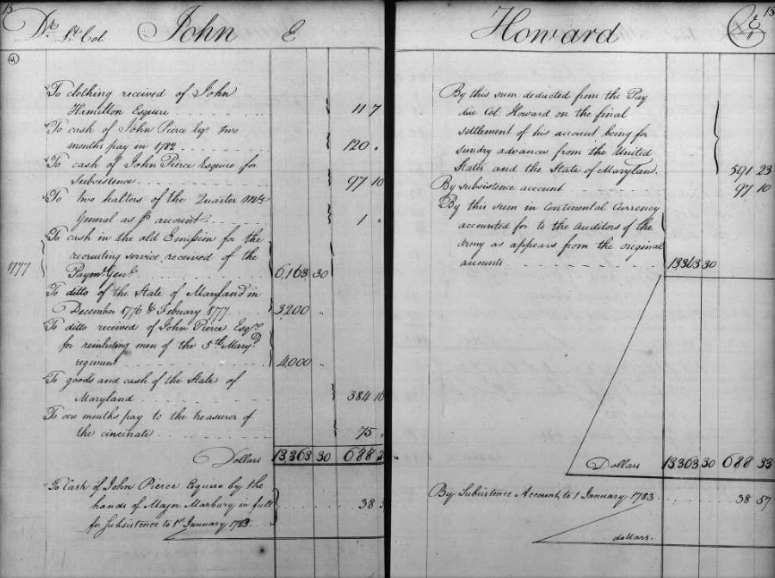
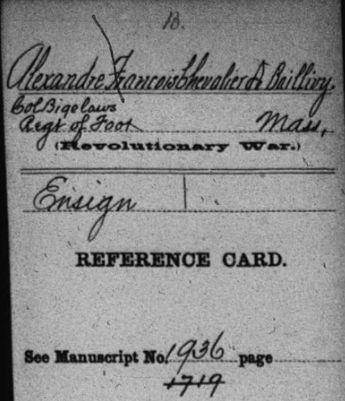
If the Special Index gives a “manuscript number,” (Fig. 4) check publication M859, Miscellaneous Numbered Records (the Manuscript File) in the War Department collection of Revolutionary War Records, 1775-1790s at FamilySearch. The descriptive pamphlet is there as well. This collection includes a wide variety of materials in numerical order with a stamped number at the top of the first page of each record. These items include mostly pay and supplies, but also have correspondence, enlistment papers, oaths of allegiance, resignations, and other items.
Naval Documents of the American Revolution
The Naval History and Heritage Command (NHHC) published thirteen volumes (16,000 pages) entitled Naval Documents of the American Revolution, covering the naval history of the American Revolution from December 1, 1774-August 15, 1778. The NHHC website provides downloadable PDFs of the thirteen volumes published to date (Fig. 5). They include correspondence, petitions, ship’s logs, muster rolls, orders, official reports, diary excerpts, and newspaper accounts on naval affairs documenting the American Revolution in the North American and European theaters of operation. The collection includes American, British, French, and Spanish points of view and gives voice to common seamen, civilians, women, and slaves, as well as policy makers, political leaders, and naval and military officers. These volumes are also freely available at HathiTrust.org.
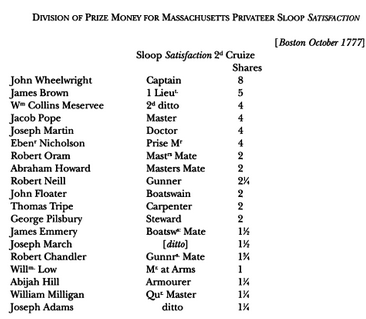
Papers of the Continental Congress (PCC) (in RG 360, Records of the Continental and Confederation Congresses and the Constitutional Convention)
The PCC, though they contain much correspondence between those coordinating the war, also include many references to ordinary citizens. Three card indexes have been included to better access “the papers.” Card Index No. 1 covers item numbers 12A, 14-16, 18, 19, 49-77, 79-115 and 157 of the Papers. This index is arranged alphabetically by name of person or by subject. Card Index No. 2 covers letters addressed to Congress, 1775-1789; and item no. 78. This index is arranged alphabetically by name of person. Card Index No. 3 covers Oaths of Allegiance and Oaths of Office, 1776-1789; and item 195. You can find the Papers for free at FamilySearch and Fold3.com. FamilySearch also has a digitized five-volume set of John P. Butler’s Index: Papers of the Continental Congress, 1774-1789. The Index will give you the exact microfilm publication number, roll number, and item number you want in NARA publication M247, Papers of the Continental Congress and M332, Miscellaneous Papers of the Continental Congress (Fig. 6). You can search the PCC by personal name, geographic location, subject, military unit name, or by regimental or company commanders’ names.

American Archives
In 1837 printer and former mayor of Washington, DC Peter Force began collecting thousands of pamphlets, booklets, and newspaper articles pertaining to the “Origin, Settlement, and Progress of the Colonies in North America” from the Revolutionary Era so he could preserve them for future generations. He published them in nine large volumes that he called the American Archives. By the late twentieth century his collection of materials covering 1774-1776 had become a valuable scholarly resource since it contained the only surviving copies of many important documents. You can search American Archives by going here and clicking on “Browse” and then on ”Advanced Search.” Enter your search terms, including names, and click “Search” to get your results (Fig. 7). Results will be shown in text form. Remember that this set covers 1774-1776 only.
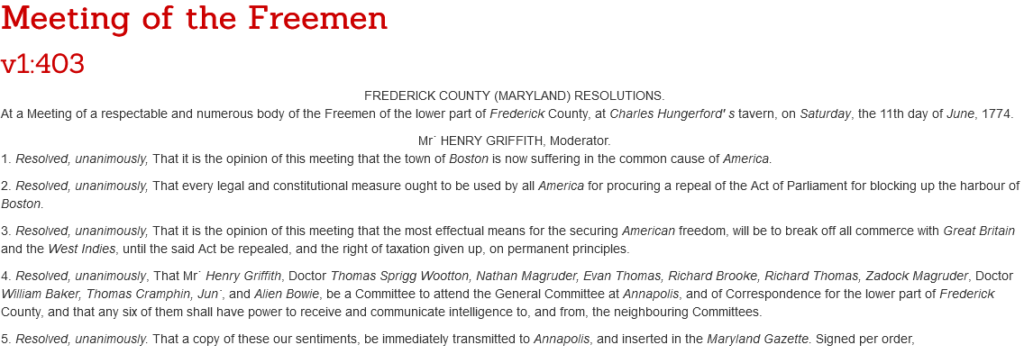
State Revolutionary War Records
In some cases, printed and digital state Revolutionary-era records are available. You can try an Internet search for your state archives or historical society, or do a search for “[state]” and “revolutionary war records.” Some examples include the following:
Georgia
https://www.ancestry.com/search/collections/7186/ (personal)
https://www.ancestrylibrary.com/search/collections/7186/ (Ancestry Library Edition)
Eight times between 1805 and 1833 Georgia held lotteries to distribute land, the largest held in the US. In the 1820, 1827, and 1832 lotteries, Revolutionary War veterans or their widows who met Georgia residence requirements were eligible to draw for land. You can search the Ancestry database or check the following links for books containing lists of “fortunate drawers.”
- Invalid or indigent veteran of Revolutionary War or War of 1812 – two draws
- Invalid or indigent veteran of Revolutionary War or War of 1812 who was a fortunate drawer in either previous land lottery – one draw
- Widow, husband killed in Revolutionary War, War of 1812 or Indian War, three-year residence in Georgia – two draws
- Widow, husband killed in Revolutionary War, War of 1812, or Indian War, three-year residence in Georgia – two draws
- Veteran of Revolutionary War – two draws
- Veteran of Revolutionary War who had been a fortunate drawer in any previous Lottery – one draw
- Widow, husband killed or died in Revolutionary War, War of 1812, or Indian Wars, three-year residence in Georgia – two draws
- Veteran of Revolutionary War – two draws
- Veteran of Revolutionary War who had been a fortunate drawer in any previous lottery – one draw
North Carolina and Tennessee, U.S., Revolutionary War Land Warrants, 1783-1843
https://www.ancestry.com/search/collections/2885/ (personal)
https://www.ancestrylibrary.com/search/collections/2885/ (Ancestry Library Edition)
After the Revolutionary War the new federal government issued bounty land warrants to qualified veterans wherever they lived, but several of the thirteen new states offered these warrants to their own veterans. North Carolina set aside land in upper Middle Tennessee as a military reservation for soldiers (or their heirs) who served in the North Carolina Continental Line during the war. Tennessee was a western county of North Carolina until it became a separate state in 1796.
Pennsylvania
Pennsylvania’s Revolutionary Governments Archives
Forty-three collections including accounts and reports, military and political appointments, oaths of allegiance, and more.
Virginia
Revolutionary War Public Service Claims Commissioners Books, 1783
These are reimbursement claims submitted by Virginia residents who supplied goods and services to the militia, state line, and Continental Army during the war. They may include certificates, county court booklets and lists, rejected claims lists, and the claim commissioners account books. The Library of Virginia has a searchable index but the originals are available on microfilm and can be borrowed via inter-library loan. Rejected claims records have not been microfilmed. You can view the original documents on FamilySearch. These claims have also been transcribed and published in volumes as Virginia Revolutionary Publick Claims, on the shelf at Grapevine Library.
Virginia Military District Lands of Ohio; Indexes
These documents are also available on FamilySearch. VMD lands were given by Virginia as a reward to her Revolutionary War soldiers or their heirs. A printed list of all entries can be viewed here.
The Daughters of the American Revolution (DAR) has also published individual state books where you may find lesser-known state resources, also at Grapevine:
- Virginia in the American Revolution: A Source Guide for Genealogists and Historians
- New York in the American revolution: A Source Guide for Genealogists and Historians
- South Carolina in the American Revolution: A Source Guide for Genealogists and Historians
- Georgia in the American Revolution: A Source Guide for Genealogists and Historians
- Rhode Island in the American Revolution: A Source Guide for Genealogists and Historians
- Massachusetts and Maine in the American Revolution: A Source Guide for Genealogists and Historians
- North Carolina in the American Revolution: A Source Guide for Genealogists and Historians
Bockstruck, Lloyd DeWitt. Revolutionary War Bounty Land Grants Awarded by State Governments.
Federal bounty land warrants are commonly sought by genealogists, but states also awarded bounty lands to their qualified veterans. This book lists recipients of bounty lands awarded by the states, along with each state’s land policies. If a veteran doesn’t qualify or appear in these records, check for the possibility of a special legislative act passed on his behalf. Some state legislative acts have been digitized; others appear in book form.
Other Resources
The book Forgotten Patriots – African American and American Indian Patriots in the Revolutionary War: A Guide to Service, Sources, and Studies, 2nd ed., by Eric G. Grundset for the DAR, identifies over 6,600 names of African Americans and American Indians who contributed to American independence. It includes details of the documented service of the listed Patriots, historical commentary on happenings of the time, an assortment of illustrations, and an extensive bibliography of research sources related to the topic. A free downloadable version is also available.🍇


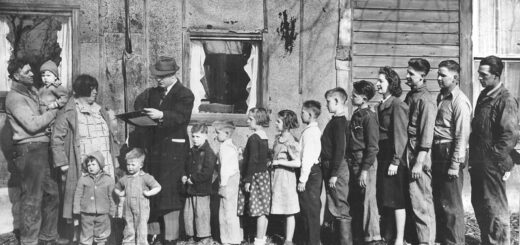
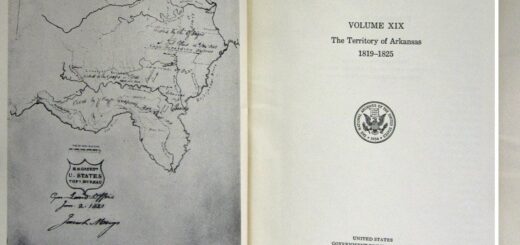

Recent Comments